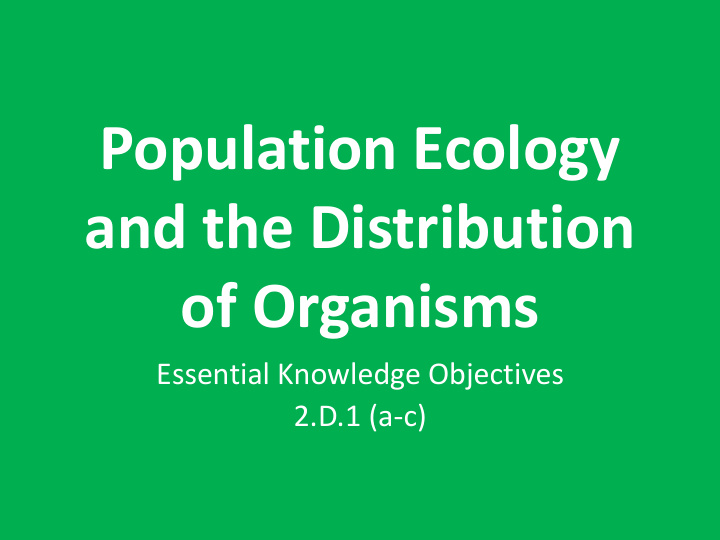



Population Ecology and the Distribution of Organisms Essential Knowledge Objectives 2.D.1 (a-c)
Ecology • The scientific study of the interactions between organisms and the environment • Ecological hierarchy from global ecology to organismal ecology • Why is it important to study ecology?
Ecological Hierarchy • Organism • Population • Community • Ecosystem • Biome • Biosphere
Population • A group of individuals of the same species living in an area
Community • A group of populations of different species in an area
Ecosystem • A community of organisms (biotic) in an area and the physical factors (abiotic) with which those organisms interact
Biome • Major life zones characterized by vegetation type (terrestrial) or by the physical environment (aquatic biomes)
Terrestrial Biomes
Terrestrial Biomes • Using pp. 824-826, write down one characteristic of each of the following biomes in your notes: – Tropical Forest – Savanna – Desert – Chaparral – Temperate Grassland – Northern Coniferous Forest – Temperate Broadleaf Forest – Tundra
Aquatic Biomes
Aquatic Biomes • Using pp. 827-829, write down one characteristic of each of the following biomes in your notes: – Wetlands and Estuaries – Lakes – Streams and Rivers – Intertidal Zone – Coral Reefs – Oceanic Pelagic Zone – Marine Benthic Zone
Biosphere • The global ecosystem – the sum of all the planet’s ecosystems and landscapes
Distribution of Organisms
Distribution of Organisms • Abiotic and biotic factors influence the distribution of organisms on Earth • Climate is a significant factor affecting organism distribution (temperature, precipitation, sunlight, wind) • Climate is moderated by large bodies of water and mountains, seasonal variations in climate
Seasonal Variation in Sunlight Intensity
Ocean Moderates Climate
Mountains: Rain Shadow Effect
Abiotic Factors • Non-living physical and chemical factors that affect an organisms ability to survive and reproduce Look at the coral reef ecosystem on the next slide. Provide a few examples of abiotic factors that affect the organisms of this ecosystem.
Biotic Factors • Living things or their materials that directly or indirectly affect an organism in its environment Look at the forest ecosystem on the next slide. Provide a few examples of biotic factors that affect the organisms of this ecosystem.
Abiotic and Biotic Factors • Cellular activities are affected by interactions with biotic and abiotic factors • Organism activities are affected by interactions with biotic and abiotic factors
Abiotic Factors Affect Cellular Activities
Biofilm • Communities of surface-associated microorganisms encased in a self-produced extracellular matrix • Found on almost all natural and artificial surfaces • Dental plaque and slime on watery surfaces
Abiotic and Biotic Factors Affect Organism Activities
Abiotic and Biotic Factors Affect Stability • The stability of populations, communities and ecosystems is affected by interactions with abiotic and biotic factors • Examples: food chains and food webs, algal blooms, species diversity, population density
Global Distribution of Apes
Distribution of Species • Interactions between populations affect the geographic distributions and abundance of populations Example: Flowers and pollinators, parasites and their hosts
Properties of Populations
Population Dynamics • Population dynamics is the branch of life sciences that studies the size and age composition of populations as dynamic systems, and the biological and environmental processes driving them
Properties of Populations • Population Size • Population Density • Births, Deaths, Immigration and Emigration • Distribution and Dispersion • Survivorship Curves • Age Structure Diagrams
Population Density • Density: Number of individuals per unit area or volume • How do we determine population density?
Factors Affecting Population Density • Density changes as individuals are added or removed from a population • Births, deaths, immigration and emigration
Population Density of the US
Dispersion Patterns • Interactions between populations affect their distribution within a geographic area
Survivorship Curves • Graph showing the number or proportion of individuals surviving to each age for a given species
Survivorship Curves • Type I – low death rate early in life, death rates increase rapidly in old age (humans, large mammals) • Type II – constant death rate over the organism’s life span (birds) • Type III – high death rate early, produce large numbers of offspring but provide little or no care (fish, plants)
Age Structure Diagrams • Diagrams that show the relative numbers of individuals at each age and fecundity (ability to produce abundant healthy offspring) • Used to predict human population changes
Recommend
More recommend